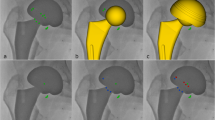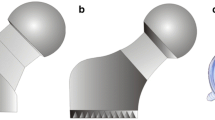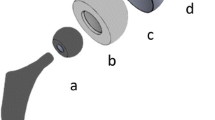Abstract
Purpose
The linear penetration rate (LPR) has been used to estimate volumetric wear ever since metal-on-polyethylene bearings were first introduced. Annual volumetric wear and osteolysis are interrelated. The use of dual mobility cups has increased; however, the presence of two bearings needs paraclinical monitoring of wear to anticipate potential wear-related complications. Is LPR correlated to volumetric wear?
Methods
Ninety-eight dual mobility liner retrievals were mapped in three-dimensions (3D) with a fully automatic stripe light scanner. Martell’s method was applied to 3D maps of the explants to determine how much the centres of the inner and outer bearings had shifted in the three planes, and in particular, penetration of the femoral head in the “z” axis. The total, inner and outer wear volumes were then compared to the shift in the centres of rotation (COR) and the pre-operative X-rays.
Results
There was no relationship between wear and head penetration into the liner. There was a statistically significant relationship between the 3D centre of rotation shift and inner wear or total wear. Wear was multidirectional.
Conclusions
LPR is ineffective for estimating wear of dual mobility inserts, since its wear not two-dimensional. In the future, a 3D imaging method with very thin slices could be used to monitor the wear of dual mobility inserts by measuring the shift in the centres of rotation, once artifacts are overcome.




Similar content being viewed by others
References
Dumbleton JH, Manley MT, Edidin AA (2002) A literature review of the association between wear rate and osteolysis in total hip arthroplasty. J Arthroplasty 17:649–661
Devane PA, Horne JG, Martin K et al (1997) Three-dimensional polyethylene wear of a press-fit titanium prosthesis. Factors influencing generation of polyethylene debris. J Arthroplasty 12:256–266
Martell JM, Berdia S (1997) Determination of polyethylene wear in total hip replacements with use of digital radiographs. J Bone Joint Surg Am 79:1635–1641
Martell JM, Leopold SS, Liu X (2000) The effect of joint loading on acetabular wear measurement in total hip arthroplasty. J Arthroplasty 15:512–518. doi:10.1054/arth.2000.4336
Boyer B, Philippot R, Geringer J, Farizon F (2012) Primary total hip arthroplasty with dual mobility socket to prevent dislocation: a 22-year follow-up of 240 hips. Int Orthop 36:511–518. doi:10.1007/s00264-011-1289-4
Buford A, Goswami T (2004) Review of wear mechanisms in hip implants: paper I – general. Mater Des 25:385–393. doi:10.1016/j.matdes.2003.11.010
Farizon F, de Lavison R, Azoulai JJ, Bousquet G (1998) Results with a cementless alumina-coated cup with dual mobility. A twelve-year follow-up study. Int Orthop 22:219–224
Pineau V, Lebel B, Gouzy S et al (2010) Dual mobility hip arthroplasty wear measurement: experimental accuracy assessment using radiostereometric analysis (RSA). Orthop Traumatol Surg Res 96(6):609–615. doi:10.1016/j.otsr.2010.04.007
Blunt L, Jiang XQ (2000) Three dimensional measurement of the surface topography of ceramic and metallic orthopaedic joint prostheses. J Mater Sci Mater Med 11:235–246
Lecuire F, Benareau I, Rubini J, Basso M (2004) Intra-prosthetic dislocation of the Bousquet dual mobility socket. Rev Chir Orthopédique Réparatrice Appar Mot 90:249–255
Philippot R, Boyer B, Farizon F (2013) Intraprosthetic dislocation: a specific complication of the dual-mobility system. Clin Orthop 471(3):965–970. doi:10.1007/s11999-012-2639-2
Boyer B, Neri T, Geringer J et al (2016) Understanding wear in dual mobility total hip replacement: first generation explant wear patterns. Int Orthop. doi:10.1007/s00264-016-3362-5
Gomes PF, Sesselmann M, Faria CDCM et al (2010) Measurement of scapular kinematics with the moiré fringe projection technique. J Biomech 43:1215–1219. doi:10.1016/j.jbiomech.2009.12.015
Jiang C, Jia S, Xu Y et al (2015) The application of multi-frequency fringe projection profilometry on the measurement of biological tissues. Biomed Mater Eng 26(Suppl 1):S395–S403. doi:10.3233/BME-151328
Affatato S, Spinelli M, Zavalloni M et al (2008) Tribology and total hip joint replacement: current concepts in mechanical simulation. Med Eng Phys 30:1305–1317. doi:10.1016/j.medengphy.2008.07.006
Charnley J, Kamangar A, Longfield MD (1969) The optimum size of prosthetic heads in relation to the wear of plastic sockets in total replacement of the hip. Med Biol Eng 7:31–39
Geringer J, Boyer B, Farizon F (2011) Understanding the dual mobility concept for total hip arthroplasty. Investigations on a multiscale analysis-highlighting the role of arthrofibrosis. Wear 271:2379–2385. doi:10.1016/j.wear.2011.02.027
Author information
Authors and Affiliations
Corresponding author
Ethics declarations
Conflict of interest
Bertrand Boyer was a consultant for SERF (Décines, France).
Thomas Neri is a consultant for SERF (Décines, France).
Rémi Philippot and Frédéric Farizon receive royalties from SERF (Décines, France).
Alexandre Di Iorio and Jean Geringer have no conflict of interest concerning this study.
Ethical review committee statement
As this study involves only implant retrieval, anonymously collected, the Ethical Review Committee approval was not required for this study, according to the Ethical Review Committee from our institution.
Funding
No funding was necessary for this study.
Rights and permissions
About this article
Cite this article
Boyer, B., Neri, T., Di Iorio, A. et al. The linear penetration rate is not relevant for evaluating wear of dual mobility cups: an explant study. International Orthopaedics (SICOT) 41, 599–603 (2017). https://doi.org/10.1007/s00264-017-3406-5
Received:
Accepted:
Published:
Issue Date:
DOI: https://doi.org/10.1007/s00264-017-3406-5




